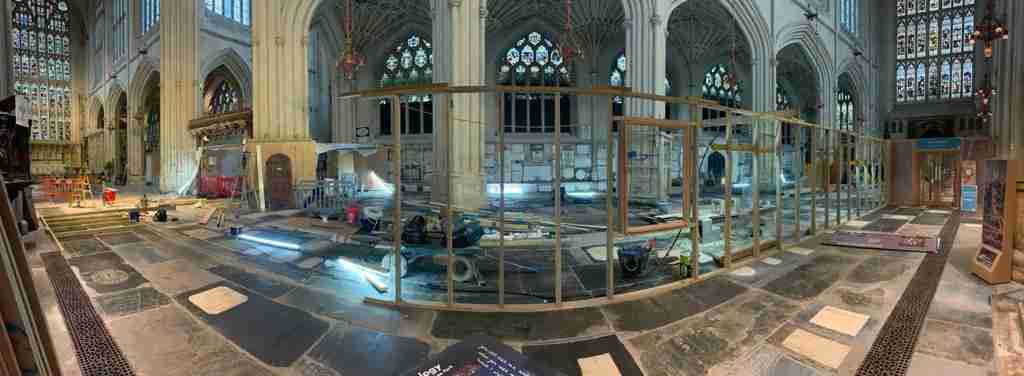The last ledgerstones to complete the restoration of Bath Abbey’s floor will be re-laid later this week as part of the Abbey’s Footprint project to save its historic floor from collapse.
Parts of the Abbey’s floor had been gradually sinking for years before excavations in 2011 uncovered massive voids caused by thousands of church burials decomposing over time, making the floor unstable. Work began in May 2018 to lift up the Abbey’s floor stone by stone, fill in the voids beneath, as well as to carefully restore and re-lay over 2,000 floor stones including 891 ledgerstones (inscribed floor stones usually found in churches to commemorate burials).
In addition, underfloor heating pipes have been installed throughout for an innovative eco-heating system that will be powered by sustainable energy from Bath’s hot springs. Prior to this, the Abbey had to rely on an antiquated heating system that dated back to Victorian times.
Now the Abbey’s historic floor has been fully restored and is safe and secure again, following almost three years of work by Emery and SSH Conservation, as well as other contractors, staff and volunteers, who have helped to complete this huge task. It is estimated that specialist heritage contractor SSH Conservation spent more than 20,000 hours on the restoration and relaying of the floor stones alone.
Felix Emery from Emery Bros. Ltd said: "We have been working on restoring the Abbey floor for 2 1/2 years and in that time have lifted over 2,000 floor stones and shifted tens of thousands of tonnes of excavated earth and stone - all of this by hand. The whole team are really pleased that the completed work will soon be handed back over to the Abbey and reopen to the public so locals and visitors to the city can appreciate our efforts restoring this beautiful church."
Nathan Ward, Footprint Project Director, said: “Our first ledgerstone was re-laid in the Abbey almost two years to this day in January 2019, so we’re very excited that the final one is going back in next week. Work will continue on the final aspects of the eco-heating system so the Abbey could be running on renewable heat by the end of March.”
In addition, volunteers from the local community and students from the University of Bath, Bath Spa University and the University of West of England, played a huge role in ensuring that all 891 stones’ positions, conditions and inscriptions were carefully documented. This will provide the Abbey with important insight into the people who lived and worked in Bath, as well as the many visitors who came to use the spa waters in the 18th and 19th centuries.
The Reverend Canon Guy Bridgewater, Rector of Bath Abbey, said: “As you can imagine, a huge amount of work has been carried out and we are so grateful to our fantastic team of staff, contractors and volunteers, not to mention the Abbey community for their support. While the Abbey is currently closed for public worship and visiting while we’re in lockdown, we cannot wait to welcome everyone back once it is safe to do so and hope they’ll be able to enjoy fully the extent of the newly restored ledgerstones and heating that is powered by Bath’s thermal springs.”
The next few months will be spent on building work in the vaults below to create new visitor facilities in the underground space between Bath Abbey and Abbey Chambers, as well as in the adjacent terrace row of houses in Kingston Buildings which will house the new Song School.
The Abbey’s Footprint project is a £19.3 million programme of work, supported by the National Lottery Heritage Fund, that will provide new spaces for learning, music and interpretation, better visitor facilities, undertake essential conservation work, as well as opportunities for volunteer and community involvement. It will secure the Abbey’s physical future and improve its hospitality, worship and service to the city. More information can be found on our website: www.bathabbey.org.

